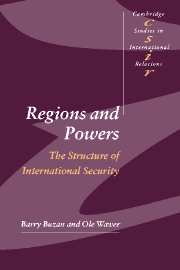Book contents
- Frontmatter
- Contents
- List of illustrations
- Preface
- List of abbreviations
- 1 Patterns of regional security during the Cold War
- 2 Patterns of regional security post-Cold War
- Part I Introduction: developing a regional approach to global security
- Introduction
- 1 Theories and histories about the structure of contemporary international security
- 2 Levels: distinguishing the regional from the global
- 3 Security complexes: a theory of regional security
- Conclusions
- Part II Asia
- Part III The Middle East and Africa
- Part IV The Americas
- Part V The Europes
- Part VI Conclusions
- Glossary
- References
- News media
- Index of names
- General Index
- CAMBRIDGE STUDIES IN INTERNATIONAL RELATIONS
Conclusions
Published online by Cambridge University Press: 05 December 2009
- Frontmatter
- Contents
- List of illustrations
- Preface
- List of abbreviations
- 1 Patterns of regional security during the Cold War
- 2 Patterns of regional security post-Cold War
- Part I Introduction: developing a regional approach to global security
- Introduction
- 1 Theories and histories about the structure of contemporary international security
- 2 Levels: distinguishing the regional from the global
- 3 Security complexes: a theory of regional security
- Conclusions
- Part II Asia
- Part III The Middle East and Africa
- Part IV The Americas
- Part V The Europes
- Part VI Conclusions
- Glossary
- References
- News media
- Index of names
- General Index
- CAMBRIDGE STUDIES IN INTERNATIONAL RELATIONS
Summary
Throughout these three chapters we have referred to regional security complex theory as a theory, and this claim needs to be explained. Indeed, for the study of regions, RSCT might be the only existing theory of regional security. Some typologies, matrixes, and checklists exist, but hardly anything that qualifies as theory. In the field of security/strategic studies, theories exist for specific problems: deterrence, alliances, not of (regional) security as such. Finally, theories have been developed for security orders – security community (Deutsch et al. 1957; Adler and Barnett 1998), zones of peace/stable peace (Kacowicz 1998; Kacowicz et al. 2000), collective security (Claude 1984; Morgenthau 1978: 417–29; Finlayson and Zacher 1983), security regimes (Jervis 1982; Inbar 1995), and concerts (Kupchan and Kupchan 1991) – but these are, in the nature of things, valid only for some situations. The only candidates for theories of regional security are those that deny the issue any specificity and therefore unproblematically integrate it into general theories such as neorealism.
The nature of (this) theory
The answer to the question of whether or not something qualifies as theory often depends on where it is asked. Many Europeans use the term theory for anything that organises a field systematically, structures questions, and establishes a coherent and rigorous set of interrelated concepts and categories. Americans, however, often demand that a theory strictly explains and that it contains – or is able to generate – testable hypotheses of a causal nature. RSCT clearly qualifies on the first (European) account.
- Type
- Chapter
- Information
- Regions and PowersThe Structure of International Security, pp. 83 - 90Publisher: Cambridge University PressPrint publication year: 2003

